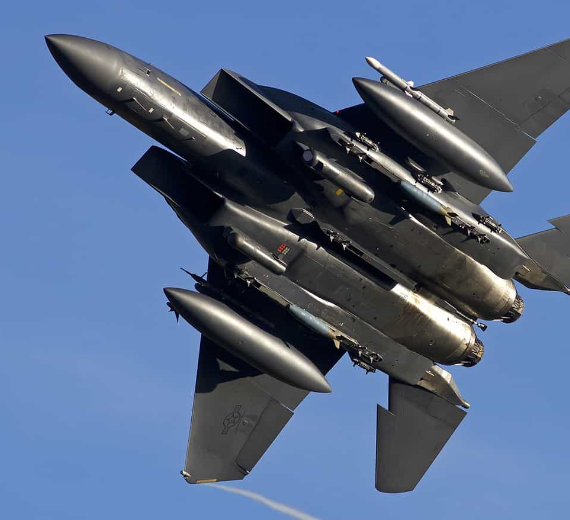Boeing F-15E Strike Eagle
Role Air superiority fighter
National origin United States
Manufacturer
McDonnell Douglas / Boeing Defense, Space & Security
First flight 27 July 1972; 51 years ago
Introduction9 January 1976; 47 years ago
Status In service
Primary users United States Air Force
Japan Air Self-Defense Force
Royal Saudi Air Force
Israeli Air Force
Produced 1972–present
Number built F-15A/B/C/D/J/DJ: 1,198
Variants
McDonnell Douglas F-15E Strike Eagle
McDonnell Douglas F-15 STOL /MTD
Mitsubishi F-15J
.
History Boeing Military
Boeing F-15E Strike Eagle

The McDonnell Douglas F-15 Eagle is an American twin-engine, all-weather tactical fighter aircraft designed by McDonnell Douglas (now part of Boeing). Following reviews of proposals, the United States Air Force (USAF) selected McDonnell Douglas's design in 1969 to meet the service's need for a dedicated air superiority fighter. The Eagle first flew in July 1972, and entered service in 1976. It is among the most successful modern fighters, with over 100 victories and no losses in aerial combat, with the majority of the kills by the Israeli Air Force
The F-15 has an all-metal semi-monocoque fuselage with a large-cantilever, shoulder-mounted wing. The wing planform of the F-15 suggests a modified cropped delta shape with a leading-edge sweepback angle of 45°. Ailerons and a simple high-lift flap are located on the trailing edge. No leading-edge maneuvering flaps are used. This complication was avoided by the combination of low wing loading and fixed leading-edge camber that varies with spanwise position along the wing. Airfoil thickness ratios vary from 6% at the root to 3% at the tip.
The F-15's maneuverability is derived from low wing loading (weight to wing area ratio) with a high thrust-to-weight ratio, enabling the aircraft to turn tightly without losing airspeed. The F-15 can climb to 30,000 feet (9,100 m) in around 60 seconds. At certain speeds, the dynamic thrust output of the dual engines is greater than the aircraft's combat weight and drag, so it has the ability to accelerate vertically. The weapons and flight-control systems are designed so that one person can safely and effectively perform air-to-air combat.[ The A and C models are single-seat variants; these were the main air-superiority versions produced. B and D models add a second seat behind the pilot for training. E models use the second seat for a weapon systems officer. Visibly, the F-15 has a unique feature vis-à-vis other modern fighter aircraft; it does not have the distinctive "turkey feather" aerodynamic exhaust petals covering its engine nozzles. Following problems during development of its exhaust petal design, including dislodgment during flight, the decision was made to remove them, resulting in a 3% aerodynamic drag increase.[0
KmCeiling
0
KmRange
0
MachAircraft Speed
0
Max Crew
Photo Gallery
Boeing F-15E Strike Eagle


Boeing Military Airplanes
Boeing F-15E Strike Eagle
General characteristics
- Crew: 1
- Length: 63 ft 9 in (19.43 m)
- Wingspan: 42 ft 10 in (13.06 m)
- Height: 18 ft 6 in (5.64 m)
- Wing area: 608 sq ft (56.5 m2)
- Height: 55 ft 1 in (16.79 m)
Powerplant
- Empty weight: (12,701 kg)
- Gross weight: (20,185 kg)
- Max takeoff weight: (30,844 kg)
- Fuel capacity: (6,103 kg) internal
- Powerplant: 2 × Pratt & Whitney F100-PW-220 afterburning turbofans, 14,590 lbf (64.9 kN) thrust each dry, 23,770 lbf (105.7 kN) with afterburner
Specifications
-
Maximum speed: Mach 2.5 (1,650 mph, 2,655 km/h) at high altitude
- Mach 1.2, 800 kn (921 mph; 1,482 km/h) at sea level
- Combat range: 1,965 km) for interdiction mission
- Ferry range: (3,500 mi, 5,600 km) with conformal fuel tanks
- Service ceiling: (20,000 m)
- g limits: +9
- Thrust/weight: 1.07 (1.26 with loaded weight and 50% internal fuel)
Armament
- Guns: 1× 20 mm (0.787 in) M61A1 Vulcan 6-barrel rotary cannon, 940 rounds
- Hardpoints: Total 9: two under-wing (each with additional two missile launch rails), four under-fuselage (for semi-recessed carriage of AIM-7 Sparrows) and a single centerline pylon station, optional fuselage pylons (which may include conformal fuel tanks) with a capacity of (7,300 kg),
-
Boeing F-15E Strike Eagle
Links to Youtube & Others
The Eagle can be armed with combinations of four different air-to-air weapons: AIM-7F/M Sparrow missiles or AIM-120 AMRAAM advanced medium-range air-to-air missiles on its lower fuselage corners.
Boeing F-15E Strike Eagle
The F-15 was shown to be capable of controlled flight with only one wing after an Israeli F-15D suffered a mid-air collision
Youtube Link
The F-15 was shown to be capable of controlled flight with only one wing after an Israeli F-15D suffered a mid-air collision










.svg.png)


